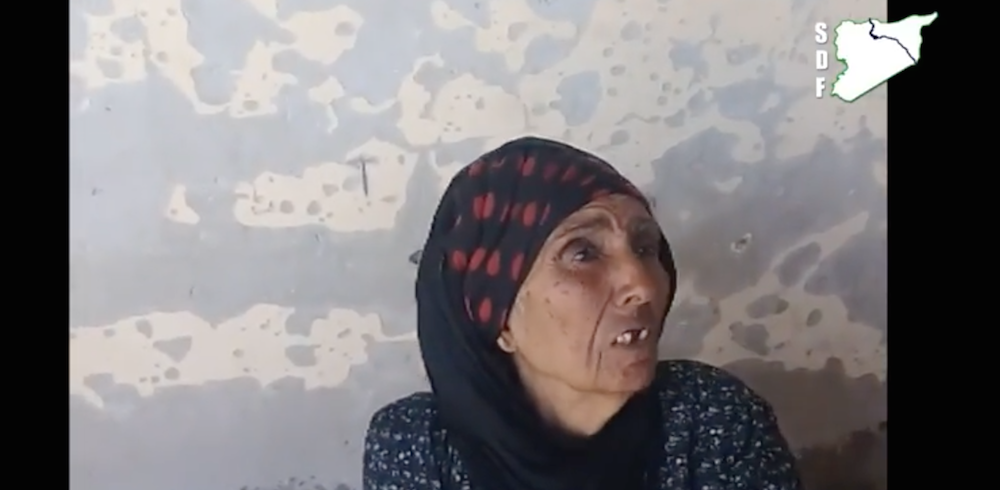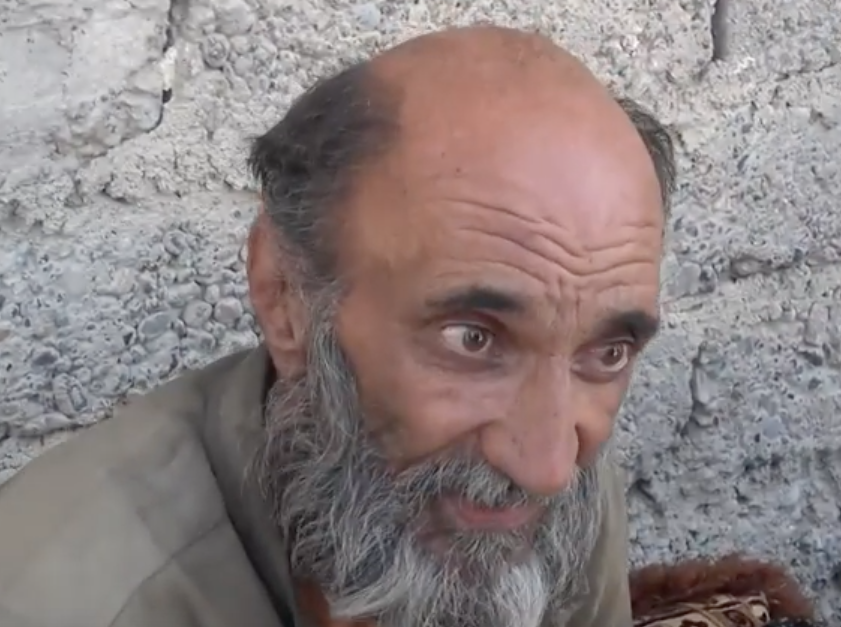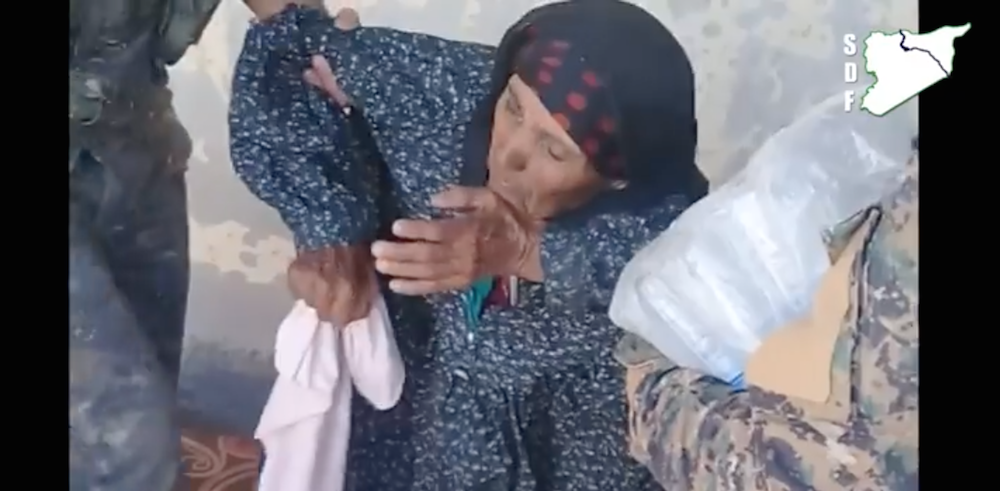(Zaman al-Wasl) Al-Raqqah once deeply connected to the name al-Rashid for centuries, is now only known as ‘the capital of the Islamic State’.
For this privilege alone, the city and all its civilians, according to the Islamic State, must pay the heavy price of death and displacement without anyone turning to them or articulating what they are experiencing, even if their suffering shocks the imagination even in the Syrian context. In this report, Zaman al-Wasl presents one such story that calls into question our ideas what we think is humanly possible to bear.
On Thursday of last week, yet another surrealist image was added to the archive of images generated in the Syrian war. The image showed an old man, his face wrinkled by fear, frustration, and mal nutrition, and next to him a woman lying on her back hiding her face with her thin hand.
Death is Their God
Images are worth a thousand words or even a million words at times, but in this case, the image is perhaps 1000 times smaller than the story of the man and woman portrayed. The image was taken by a photographer for AFP and used by the Syrian Democratic Forces in their propaganda for their fighters to market the SDF’s humanitarian approach in dealing with civilians.

The SDF forces filmed the woman and man and broadcasted the video entitled ‘Saving a paralyzed elderly man from inevitable death in al-Raqqah city’ on July 13, 2017.
The video showed a number of SDF fighters enter the old woman’s home, and the first question they ask is about the corpses lying next to her. The fighters kept asking how these people died and the woman kept repeated that they died ‘their God’s way’, meaning naturally, until the fighters stopped asking her.
The old woman begged the SDF forces to help her, telling them that she is paralyzed in the local dialect of Palmyra. She then said with much confusion and maternal affection, “my daughters are with, my daughters are with you.” One of the fighters asked, “Your daughters are with us, really?” The woman backed down repeating, “I don’t know where they are” then repeating, “my daughters and son are with you.”
In the video, the SDF fighters try to convince the woman to come with them several times, but she refused looking out of the corner of her eye at the two corpses in the side of the room as if to say, “where would I leave them?”

The fighters try to reassure her saying they will bury the bodies, but she remained resistant and returned to ask about her daughters. The fighters finally convinced her by answering that her daughters are with them. The old woman gathered some clothes in a cloth and tied it around her waist as she muttered about the bitterness of life and her heartache.
At the end of the video an old man appears next to the old woman. He answers some of the questions a journalist, accompanying the SDF fighters, addresses to him showing his simplicity while the old woman tries to interrupt him and draw the journalist’s attention to her.
This is the story of the old woman, as presented in the video, a story that may resemble the stories of tens of thousands of Syrians pounded by the war. The stories of thousands of Syrians have become juicy material for different countries, organizations, factions and media outlets to race to broadcast and publish based on their agendas and purpose, but the facts behind the scenes of this video tell a story of the intolerable.
Speaking to Zaman al-Wasl, a special source recounted the old woman and her family’s story. The source not only comes from the same city but also is familiar with many of the details of her life.
The source explained that the old woman is one Amina Ahmed al-Abeed, known as Oum Faisal, and she is barely 80 years old. He said that the man who appeared next to her in the video is her son Abdul Halim Alawai al-Talib, who war has aged greatly in recent years so he appears much older than he actually is.

Coming from Palmyra means Amina and her family’s story is no less exceptional than the story of Palmyra city itself given the regime and the Islamic State have taken control of the city more than once. The people of Palmyra have thus been between an anvil and hammer repeatedly distinguishing their stories from those of other Syrians.
Amina al-Abeed was widowed long ago, and took on the burden of raising all her children (males and females), but all the hardship of the past seven decades are nothing compared to the horrors of recent years.
According to our source, Amina and her children were displaced from Palmyra shortly after the Islamic State first took control of the area (summer of 2015), as a result of regime bombardment on the city under the pretext of trying to expel the Islamic State. The old woman left her house, afraid and confused, and only found al-Raqqah city before her and her children.
A Daeshi Here and an Agent There
During the family’s escape from Palmyra, the mother and her sons lost each other and when they reunited, they found that Abdul Halim was not among them. He is known for his simplicity and his dependency. The family’s inability to return and look for him only increased their suffering.
The old woman and her children settled in al-Raqqah, while Abdul Halim remained in Palmyra where he managed to get by as best he could. Then the regime retook the city and harassed what the residents who remained on the basis they hosted Daesh (the Islamic State) just as the Islamic State forces had harassed many of the people of Palmyra on the basis they are regime agents.
Abdul Halim was unable to flee when the regime retook the city, and he remained in there. His family received no news from him for a while and they came to believe that Abdul Halim must have been killed by the regime or its militias. Then news of him reached them once more through word of mouth when two months after the regime took Palmyra, he reappeared in the city again. When asked by people where he was, Abdul Halim said that he “was dragged to Damascus” in a reference to the regime intelligence.
Abdul Halim's misery, his long beard and the fact he remained in the city were sufficient reasons to make the regime suspicious and arrest him in the spring of 2016. His continued presence in Palmyra after the Islamic State returned to Palmyra for the second time in late 2016 was sufficient justification for the Islamic State to suspect him and send him to a nearby city where he was made to undergo a “Sharia course,” although Abdul Halim is illiterate.
Abdul Halim embodies the tragedy of Palmyra’s people, caught between the jaws of the regime and the Islamic State. In the eyes of the latter they are Daeshis (Islamic State members or supporters) and for the former they are [regime] agents. But in reality, they have tasted the most horrors from both sides in Syria, especially given the number of times control over Palmyra and its surroundings was changed (4 times).
After returning from his exile and completing the Sharia course, Abdul Halim was not sure who was in control of Palmyra at the time. To avoid the evil of both sides, the man decided to hide in his home and not leave. A few days later, one of his nephews who was still in the city, passed by to check up on him. The nephew found Abdul Halim in a terrible condition as he had been without food or drink for several days. The nephew carried Abdul Halim and transported him to al-Raqqah where the family was reunited.
A few months later, the Coalition and its allies launched ‘The battle to liberate al-Raqqah’. The smoke and dust of this battle has killed many innocent people, without raising much concern for the civilian death tolls. According to Zaman al-Wasl’s source, some of Amina’s children are among the innocent people killed in the battle to liberate al-Raqqah. Amina’s children were not spared or safe from the regime, the Islamic State forces, or the Global Coalition and its allies.
The Coalition and its allies concluded the family’s tragedy with darkness as the Coalition rained bombs and rockets on al-Raqqah’s residents. One rocket fell on the old woman’s house killing two of her children Mohammad and Naayim, and injuring two of her daughters who remain in critical condition in the hospital.
The source explained in a more detailed fashion that with the intensification of the Coalition and its allies’ bombing on one of al-Raqqah’s axes, the house the family were renting was hit by a rocket.
One of the daughters was injured in that incident. The incident prompted the family to escape and move to another house which they thought was safe, but it was only a few hours later until that house too was bombed killing Mohammad and Naayim and injuring two of the daughters- including the daughter who was injured in the first bombing. Allawi, another of Amina’s sons, rushed his two sisters to hospital without managing to bury his deceased brother and sister. In this way, Amina remained in the house with only Abdul Halim.
During this time, the fighting intensified and it became more dangerous to move around. People moving between neighborhoods were either killed or arrested on the basis of being an agent for one or the other side. The family members were dispersed once again with the two injured daughters and their brother in one area, and Amina and Abdul Halim in another.
Imagine
The old woman’s tragedy was exacerbated as she lived in the same room with bodies of her deceased children for a week. A week under these circumstances is enough to make a sane person lose his mind and kill any emotional capacity he may have, so what then of the state of Amina and Abdul Halim who does not know how to take care of himself let alone someone else.
With the continued sound of terrifying bombing, the scarcity of food and drink in the house, and no solution for his deceased siblings, Abdul Halim gathered his strength and went outside to seek out someone to help him. The attacking forces arrested him without him knowing why, hence in the beginning of the video filmed by the Syrian Democratic Forces, only Amina and her two deceased children are appeared.
Zaman al-Wasl’s source, who is not only directly affected by issues concerning people from his town and with this particular family, offered some explanation for Amina’s behaviors and words including her repeated pleading with the SDF fighters, her heightened paranoia, her repetition of the phrase “they died a death of their God” despite the fact her children were killed due to someone’s actions.
The source said that these actions stem from the harsh experiences the people of Palmyra were exposed to. They were required to prove their innocence to every party that invaded the city, they became confused and reached the point of just wanting to be left in peace at all costs.
The source confirmed that Amina and Abdul Halim were unable to distinguish the fighters standing in front of them as any different to those who came before. Due to this confusion, Amina kept demanding her daughters. It also explains why she spoke in general terms at the beginning of the video and why her son did the same at the end of it.
It is only by understanding all the horror the family experienced as people from Palmyra and in knowing the particularities of their circumstances, that we can also understand why the old woman kept interrupting her son and tried to direct the journalist’s attention to her. Amina was afraid that her son would say something wrong since he does not know the newcomers standing with them nor what they consider ‘sound’ or ‘correct’. Amina was afraid her son would be pay a price for a wrong word given he was made to pay the price several times before without ever knowing what he was being accused of.
The source concluded stressing that the severity of the calamity that befell this family is hidden except to those who know them or to someone who tries to imagine what Amina must have felt lying next to the bodies of her two deceased children for a week. In trying to imagine what Amina must have felt, we must account compassionately for her worry for son Abdul Halim, and her affection mixed with pleading for her two injured daughters and their brother.
To imagine how Amina must have felt, we must image the smell of the decomposing bodies filling her nostrils, see through her eyes the fighters entering her house and her confusion and attempts to avoid being harmed by them. Through all this, we must imagine Amina’s soul, distressed from all kinds of oppression, and longing for a glimmer of justice and light.
















Comments About This Article
Please fill the fields below.